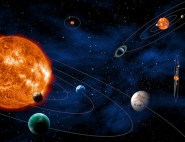Instruments
Detecting a large number of exoplanets with long orbital periods around different types of stars requires:
- a wide field of view (to increase the chances of detection)
- a large collecting area (to enable a high degree of photometric precision)
- long observation periods (to cover long orbital periods)
To meet the first two requirements, the mission concept is based on 24 identical telescopes in four groups of six. All six telescopes in each group observe the same field. The groups are slightly offset from each other so that their respective fields partially overlap. This method provides a better signal-to-noise ratio in the centre of the field of view, where the 24 telescopes’ fields of view overlap. It also increases reliability by reducing the impact of any one telescope malfunctioning. PLATO’s total field of view covers approximately 2,250 square degrees.
The two additional “fast” telescopes are designed to aid the satellite’s fine pointing. They will also provide colour data for very bright stars.
Each telescope is equipped with six lenses and offers the following features:
- 4 CCDs with 18-µm pixels
- 4,510 x 4,510 pixels per CCD
- Total height (excluding baffle): about 37 cm
- Mass: about 13.2 kg
- Readout rate: 25 seconds (2.5 s for the two fast cameras)

Schematic of one of PLATO’s cameras. Credits: PLATO Mission Consortium
Sixteen computers (plus two for the two fast cameras) will process data from the telescopes—light curves, centroids, thumbnails, etc.—and then transmit them to the Instrument Control Unit (ICU), which will concatenate the data before downlinking to ground stations. The ICU will also relay ground commands.
PLATO’s payload will weigh about 600 kg and use about 800 W of power. It will produce 200 Gb of data every day.

